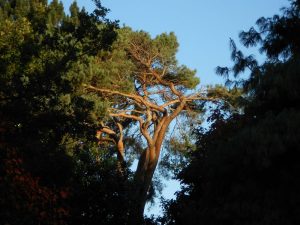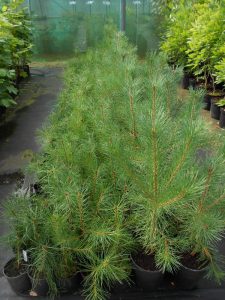The Scots Pine is an iconic tree within the Scottish landscape. Easily recognisable with its reddish trunk, best appreciated during a west coast sunset when the rays from the lowering sun hit and highlight the canopy colours within a mature tree. Now chosen as Scotland’s national tree; the Scots Pine gained 52% of the vote from those that responded to a call to vote for a national tree of Scotland.
Gertrude Jekyll, the 19 – 20th century horticulturist and author, refers in her book “Wood and Garden” to a musical note coming from the trunk of the “Scots Pine” or “Scotch Fir” as she calls Pinus sylvestris in her “notes and thoughts, practical and critical of a working amateur gardener”, published in 1899.Pinus sylvestris
Not often seen as a mature specimen in the urban environment, P. sylvestris is the tree you remember from travelling in the wild open spaces of northern Scotland; its distinctive bare trunk, topped with the flattened wind pruned canopy braced against open sky and mountain peaks.
One of the 2 needled Pines, the blue/green needles varying in length dependent on soil, situation and climate. Trees can reach 40 metres in height and provide useful timber. Once the timber was used as pit props, nowadays it is felled and milled for use in the building industry. Much also finds its way to pallets, fencing and as wood pulp. A wide ranging species geographically; native Scottish populations are now recognised as a subspecies, P. sylvestris ssp. scotica. A young plant of which can be found in the Scottish heath garden. Mature specimens of P.sylvestris are towering above the Holly windbreaks in the copse. These exhibit the mature orange colour of the trunks and at certain times of the year are lit up by the rising and setting of the sun.



1 Comment
1 Pingback